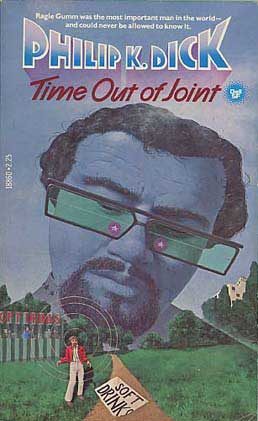
“We have a hodge-podge of leaks in our reality.”
Everyone, at some point or another, has imagined that the entire universe revolves around them. That their friends and neighbors and coworkers exist solely to play a minor part alongside their starring role. If you’re one of the fortunate ones, you’ll realize that this is obviously not the case sometime between the ages of three and eighteen. On the other hand, maybe ignorance is bliss and it’s better to live life as a raging narcissist. In any case, many people do in fact carry this fantastic misconception with them their entire lives. They function as if the concerns and ambitions of everyone else are secondary to the main objective of their own self-realization. And of course everyone else should act accordingly. You know the type (or perhaps you are the type).
Time Out of Joint, the first Philip K. Dick novel to effectively peel back a loose edge of reality, features a character for whom the above is actually true, more or less.
Raggle Gumm is a mid-forties bachelor who lives in a harmless 1950s American suburb with his sister Margo, her husband Vic, and their son Sammy. All of the characters, along with the enterprising neighbor couple, Bill and Junie Black, are fleshed out with great economy before settling in on the peculiarities of Raggle’s existence. As the book begins, the only atypical element of Mr. Gumm’s life is his occupation. Long before tech workers were allowed to spend their days playing Xbox in their PJs while logged into their work computers, Raggle Gumm was working from home. He was playing a game too. Specifically, a vaguely described puzzle game in a local newspaper called “Where Will The Little Green Man Be Next?” that sees him selecting a single square from a grid of 1208. Miraculously, he has entered and won this contest every day for going on two and a half years by intuitively interpreting hazy clues tossed at him by the universe while guzzling beer. Well, he hasn’t been perfect. He’s missed a few times, but his celebrity status is so profitable for the newspaper that they cover up his occasional failures. Although Raggle finds the contest work overwhelmingly stressful, childish, and shameful, he dutifully submits his entries like clockwork, carving out small chunks of time for flirtatious midday picnics with Junie Black and a civil defense class he was talked into by Mrs. Keitelbein.
Of course, all is not as it seems. Dick provides a few early wrinkles to hint that his version of 1950s America is not the real one. AM/FM radios are scarce, the Tucker is in production, and no one has heard of Marilyn Monroe. As lightswitches are mysteriously substituted for pull cords, soft-drink stands fade out of existence, and random strangers refer to Raggle by name, he initially believes he is having a nervous breakdown. His mind becomes weighed down by hallucinations, anomalies, and obscure metaphysical philosophies. Dissonance leads to doubt, then to inquiry, then to comparison between differing perceptions of the world. When his nephew rigs up an old crystal set and Raggle hears radio communications discussing his own whereabouts, his misgivings blossom into full blown paranoia.
Time Out of Joint is essentially one long, drawn-out breaking down of the façade built up around Raggle Gumm. As the clues begin to mount and Raggle pulls on every loose strand of his reality with increasing vigor, the point of view shifts to that of Bill Black, who confirms for us that something is indeed amiss, but that it is orchestrated. There’s a wonderfully intense sequence that finds Raggle, Vic, and Margo all crammed into Sammy’s treehouse with him, crowded around the boy’s refurbished crystal set when the Blacks frantically rush over to their house. Vic pulls a toy gun and confronts Bill Black, who instinctively thinks he’s truly been found out before realizing the weapon is fake.
Raggle Gumm is the prototypical Dick protagonist whose paranoia is proven justified by the discovery of the real world beyond his own. Unfortunately, as the author begins teasing less and revealing more, the book becomes less effective. Ragle and Vic eventually break through the Kafkaesque obstructions surrounding their town by commandeering a produce truck from the grocery store where Vic works. They discover that the entire town has been carefully constructed to resemble the 1950s despite the fact that it is actually nearing the end of the millenium. The town’s residents have been voluntarily brainwashed to keep up the charade and ensure that Raggle remains mentally stable enough to win the Green Man contest consistently. Why? Because he isn’t predicting the location of the Green Man, but the location where the human population on the moon, AKA Lunatics, will drop their next nuke. In effect, this closing section of the book underwhelms because it shifts from the pleasurable brain tickling of the buildup to an excessively explanative denouement that reads like an afternoon of pulp sci-fi brainstorming.
Despite its late-game fumble, I cherish Time Out of Joint for several reasons. Chief among them is that it was one of the first PKD books that I got my hands on and I completed it during my thru-hike of the Appalachian Trail. Oftentimes I lament that even the best books are given insufficient time to digest in the mind before they’re crowded out by other ideas and sensations and plotlines. But when the first thing you do after falling asleep reading a PKD novel is wake up and march for twelve hours, you can get some thinking done. The other reason I hold it near and dear is that it served as a clear inspiration on an episode of The Twilight Zone which in turn inspired The Truman Show.